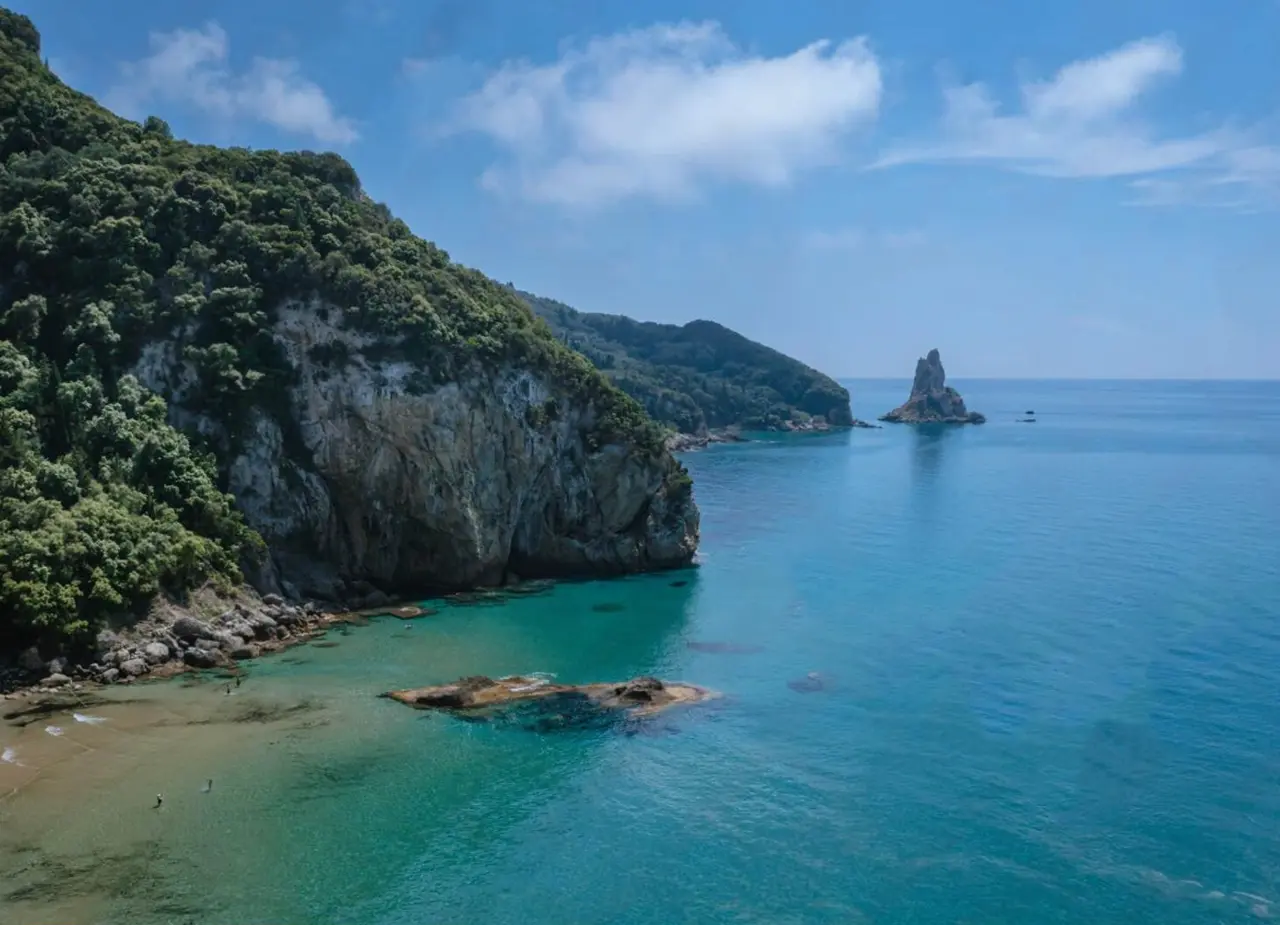Corfu Paleokastritsa Beach

Paleokastritsa is arguably the most famous location on the island of Corfu. Every year, it attracts thousands of visitors who seek tranquility and relaxation in its azure waters and breathtaking natural scenery. This unique example of Corfiot nature is located approximately 24 kilometers from the island’s main town, in one of its most idyllic spots.
The first thing that greets visitors upon arrival in Paleokastritsa is the stunning landscape lush green slopes and towering rock formations that seem to hang dramatically from the edges of the surrounding mountains. This striking setting is further enhanced by dozens of small, picturesque beaches with their soft, golden sands and the crystal-clear waters of the Ionian Sea, which lovingly embraces the region, giving it its distinct character and charm.
Taking a step back in time, we uncover a fascinating history behind this mesmerizing destination, a history that has captivated both locals and visitors throughout the centuries. Even the name “Paleokastritsa” (which translates to “Old Castle”) hints at the area’s deep historical roots. The region has been inhabited for many centuries, and there are even legends linking it to the mythical city of ancient Corcyra (the ancient name for Corfu), which was ruled by King Alcinous of the Phaeacians. According to Greek mythology, it was in this very area that Odysseus arrived before reaching his beloved homeland of Ithaca.
The legend tells of his shipwreck and subsequent rescue by Princess Nausicaa, the daughter of King Alcinous, who found him on the shore and helped him reach the royal palace.
During the Byzantine period, Paleokastritsa began to flourish due to agriculture, fishing, and olive oil production. Over time, it became a hub of trade and commerce, gaining such significance that the Byzantines decided to build a fortress nearby to protect it. Just a few kilometers northwest of Paleokastritsa, perched on a steep hill that rises from the sea to a height of 300 meters, stands Angelokastro, one of Corfu’s most remarkable historical landmarks and a vital remnant of the Byzantine era in Greece. Built in the 13th century, Angelokastro was one of the island’s most formidable fortresses during the Byzantine period. The castle was named after Michael II Komnenos Doukas, the Despot of Epirus, who strengthened Corfu’s fortifications to defend it against enemy invasions.
Angelokastro served as both a military and administrative center, and its strategic location made it nearly impregnable. Throughout the years, the fortress provided a safe haven for local inhabitants during pirate raids and Ottoman sieges. Its impressive architectural design includes high walls, imposing gates, and observation towers, which allowed defenders to monitor the surrounding sea for approaching threats. Inside the castle, there were military barracks, storage facilities, and a small church dedicated to Archangel Michael. Over time, as Corfu’s defensive strategies evolved, the castle lost its military importance and was eventually abandoned by the Venetians and other subsequent rulers of the island.
Today, Angelokastro remains an important tourist attraction, drawing visitors eager to explore its historical significance and enjoy its spectacular panoramic views. Despite the ravages of time, the ruins of the fortress still exude a sense of grandeur, reminding all who visit of its past glory and strategic importance.
Paleokastritsa Beach
One of the most remarkable natural features of Paleokastritsa is its famous sea caves, which, beyond their unrivaled beauty, hold intriguing myths and legends. These extraordinary geological formations were shaped over thousands of years as the limestone cliffs were gradually eroded by the relentless waves of the Ionian Sea. The continuous impact of water against the rock created hollows and passages, which eventually developed into the stunning caves we see today. Characterized by impressive stalactites and stalagmites, crystalline waters, and a unique play of light as sunlight filters through the water, these caves create a mesmerizing atmosphere that enchants all who visit.
The most renowned of these caves is the Cave of Nausicaa. According to mythology, this is where Princess Nausicaa found the shipwrecked Odysseus and aided him on his journey to her father’s palace. The cave is distinguished by its deep, transparent waters and the magical way in which sunlight dances upon the rocky walls, offering visitors an unforgettable experience. A short distance away lies the Cave of Saint Nicholas, famous for its spectacular entrance and striking blue-green waters, which create an ideal setting for swimming and underwater exploration.
Exploring the sea caves of Paleokastritsa is one of the top activities for visitors to the area. There are various ways to experience their beauty—boats can be rented from the beaches, allowing visitors to navigate the caves at their own pace and swim in stunning coves that are otherwise inaccessible. Additionally, for those who love adventure, there is a diving school in Paleokastritsa where beginners and experienced divers alike can take lessons and explore the underwater wonders of the region.
Beyond their aesthetic and recreational appeal, the sea caves of Paleokastritsa serve as important marine ecosystems. They are home to a rich variety of marine life, including fish, sea anemones, and other marine organisms that contribute to the area’s biodiversity. As tourism in the region increases, it is crucial to preserve these fragile ecosystems, ensuring that visitors follow environmental protection guidelines to prevent pollution and damage to the caves. Sustainable tourism practices, such as refraining from touching rock formations or disturbing marine life, play a vital role in maintaining the natural beauty of Paleokastritsa for future generations.
Paleokastritsa is a true gem of Corfu, combining breathtaking landscapes, fascinating geological wonders, and a rich historical past. Whether you are drawn by its mythological connections, its medieval fortifications, or its mesmerizing caves, this enchanting region offers something for everyone. Do not miss the chance to explore its hidden coves, walk along its rugged cliffs, engage in thrilling water sports, or simply soak in the serenity of its pristine surroundings. A visit to Paleokastritsa is an unforgettable journey through nature, history, and legend—one that leaves every traveler with memories to cherish for a lifetime.
